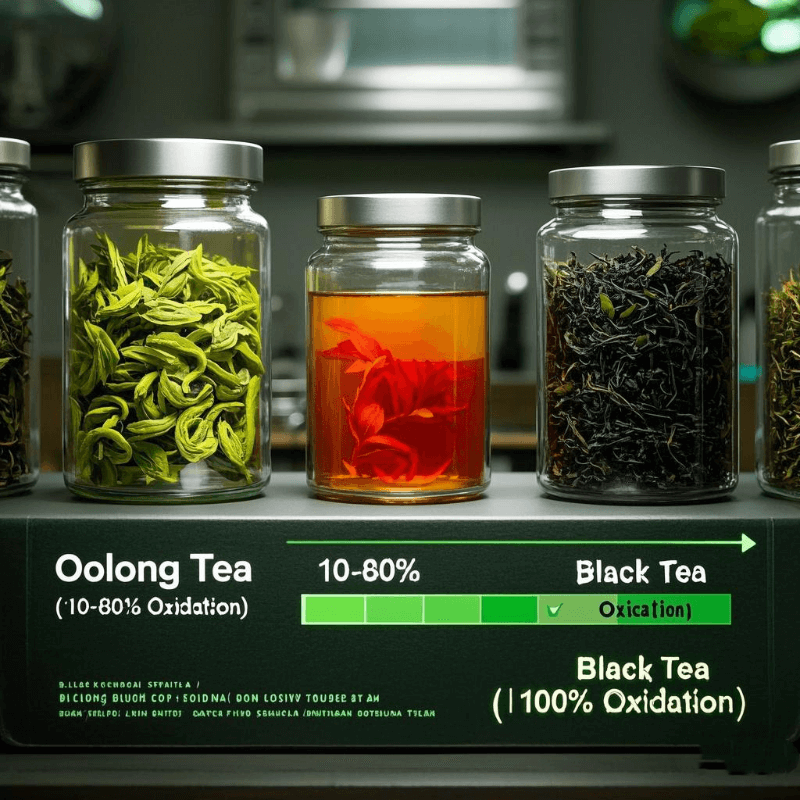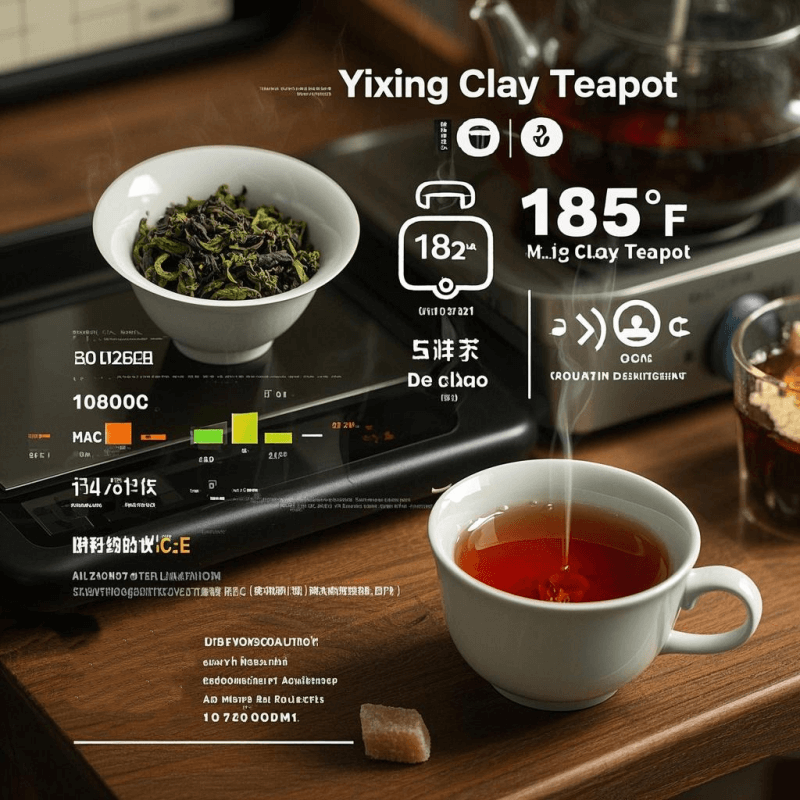In the world of specialty teas, few questions spark as much confusion as: is oolong tea black tea? For newcomers and even seasoned tea drinkers, the line between these two beloved brews can be blurry. Oolong tea’s rich, complex flavor and black tea’s bold profile often lead to misconceptions about their origins and processing. This comprehensive guide will unravel the differences, explore their unique characteristics, and help you brew each tea like a pro. Whether you’re seeking to expand your tea knowledge or find the perfect brew for your palate, understanding is oolong tea black tea is key to a more intentional tea-drinking experience.
1. Introduction: Understanding the Oolong Tea vs. Black Tea Debate
Walk into any tea shop or browse an online store, and you’ll likely encounter oolong and black teas displayed separately—yet many still wonder: is oolong tea black tea? This confusion stems from their shared heritage: both come from the Camellia sinensis plant, but their processing methods create wildly different end products.
Consider this: a cup of Assam black tea might greet you with robust maltiness, while a Wuyi oolong could reveal notes of toasted nuts and spice. The question of is oolong tea black tea isn’t just about semantics—it’s about unlocking the unique qualities of each brew. By the end of this article, you’ll not only know the answer but also how to choose, taste, and brew them with confidence.
2. What Makes Oolong Tea Different from Black Tea?

To answer is oolong tea black tea, we must first examine their defining characteristics:
Oxidation: The Key Dividing Factor
- Oolong Tea: Undergoes partial oxidation (10–80%), a process that allows leaves to oxidize partially before being heated to stop the process. This middle ground gives oolong its diverse flavor spectrum.
- Black Tea: Fully oxidized (100%), meaning leaves are left to oxidize completely. This creates its signature bold, robust character.
Expert Insight: A study by The Tea Association of the USA notes that oxidation level is the primary factor distinguishing tea categories, from unoxidized green tea to fully oxidized black tea.
Processing Methods
- Oolong Tea:
- Leaves are withered under the sun or indoors.
- They’re gently shaken to bruise edges, initiating oxidation.
- Oxidation is halted via pan-frying, baking, or steaming.
- Leaves are shaped (rolled, twisted) and dried.
- Black Tea:
- Leaves are withered to reduce moisture.
- They’re crushed or torn to accelerate oxidation.
- Oxidation proceeds until leaves turn dark brown/black.
- Leaves are dried, often in ovens.
Appearance and Brew Characteristics
- Oolong Tea: Leaves range from greenish-brown to deep black, often retaining their twisted shape. Brew color varies from pale gold to amber.
- Black Tea: Leaves are uniformly dark, often broken or crushed. Brew color is deep red-brown, almost like coffee.
3. Is Oolong Tea Black Tea? Clarifying the Confusion
The straightforward answer to is oolong tea black tea is no. While both come from the same plant, their processing and resulting characteristics place them in distinct categories:
Core Differences at a Glance
| Aspect | Oolong Tea | Black Tea |
| Oxidation Level | 10–80% (partial) | 100% (full) |
| Flavor Profile | Diverse: floral, fruity, nutty, roasted | Bold: malty, earthy, sometimes sweet |
| Caffeine Content | Moderate (30–50mg/cup) | Higher (40–70mg/cup) |
| Origin | Predominantly China (Fujian, Guangdong), Taiwan | China (Yunnan, Assam), India, Sri Lanka |
| Brew Temperature | 175–205°F (79–96°C), varies by oxidation | 212°F (100°C), boiling point |
Common Myth: Some believe oolong is a type of black tea due to its darker color, but as the table shows, oxidation level is the defining factor. A lightly oxidized oolong is closer to green tea in character, while a heavily oxidized oolong approaches black tea—but it never crosses into full black tea territory.
Cultural and Regional Context
- Oolong Tea: Revered in Chinese and Taiwanese tea cultures, where gongfu cha (ritual brewing) highlights its complex flavors. Varieties like Da Hong Pao and Tieguanyin are celebrated for their terroir-driven profiles.
- Black Tea: The staple tea of the Western world, used in blends like Earl Grey and enjoyed with milk and sugar. It’s also the base for masala chai and iced tea.
4. Taste Test: Comparing Flavor Profiles of Oolong and Black Tea
To truly understand why is oolong tea black tea is a common but incorrect assumption, let’s explore their flavor universes:
Oolong Tea: A Journey Through Flavor
- Lightly Oxidized (10–30%):
- Example: Alishan High Mountain Oolong
- Taste: Floral (orchid, jasmine), fruity (green apple, pear), fresh and delicate with a grassy finish.
- Medium Oxidized (30–60%):
- Example: Phoenix Dan Cong
- Taste: Balanced between floral and toasty, with notes of honey, ripe peach, and roasted nuts.
- Heavily Oxidized (60–80%):
- Example: Da Hong Pao
- Taste: Bold and complex, featuring dark chocolate, cinnamon, smoky oak, and a lingering mineral finish.
Black Tea: Bold and Unmistakable
- Traditional Chinese Black Tea:
- Example: Lapsang Souchong
- Taste: Smoky, earthy, with hints of pine and leather (due to pinewood smoking).
- Indian Black Tea:
- Example: Assam
- Taste: Malty, full-bodied, with a strong, robust character ideal for milk and sugar.
- Sri Lankan Black Tea (Ceylon):
- Example: Uva
- Taste: Bright, citrusy, with a brisk finish—excellent for iced tea.
Why the Confusion Persists
- Dark Oolongs: Heavily oxidized oolongs like Da Hong Pao share some flavor traits with black tea (smokiness, depth), leading to misclassification.
- Marketing Terms: Some brands may label dark oolongs as “black tea” for simplicity, confusing consumers.
Blind Taste Test Tip: Brew a heavily oxidized oolong and a black tea side by side. The oolong will reveal more nuanced layers, while the black tea will strike with upfront boldness.
5. Brewing Differences: How to Brew Each Tea the Right Way
Brewing techniques play a crucial role in bringing out the best in oolong and black tea—and understanding these differences helps answer is oolong tea black tea by highlighting their unique needs:
Brewing Oolong Tea Like a Pro
- Water Temperature:
- Light oolongs: 175–185°F (79–85°C)
- Medium oolongs: 185–195°F (85–90°C)
- Dark oolongs: 195–205°F (90–96°C)Why: Higher temperatures suit darker oolongs, while lighter ones risk bitterness at boiling point.
- Steeping Time:
- 1st steep: 1–2 minutes
- Subsequent steeps: +30 seconds each (oolong can be steeped 5–7 times)Pro Tip: Use a gaiwan (lidded bowl) for gongfu brewing to extract layered flavors.
- Leaf-to-Water Ratio:
- 1 teaspoon per 8 ounces, adjust for strength.
Try This: Savor the taste of oolong tea with traditional brewing tools to experience its full complexity.
Brewing Black Tea Correctly
- Water Temperature:
- Boiling (212°F/100°C) for most black teas, though delicate varieties like Darjeeling may prefer 200°F (93°C).
- Steeping Time:
- 3–5 minutes (over-steeping causes bitterness)
- 1–2 steeps maximum for most black teas.
- Add-Ins:
- Black tea accepts milk, sugar, honey, or lemon—experiment to find your preference.
Common Mistake: Brewing oolong tea like black tea (boiling water, long steeps) can destroy its delicate flavors. Respect each tea’s unique requirements.
6. Health Benefits of Oolong Tea and Black Tea Compared
While both teas offer health perks, their chemical compositions—shaped by oxidation—lead to different benefits:
Oolong Tea’s Health Advantages
- Weight Management: Studies suggest oolong tea may boost metabolism and aid in fat oxidation. A 2009 study in the Journal of Clinical Nutrition found that daily oolong consumption was associated with significant weight loss.
- Heart Health: The polyphenols in oolong tea may help lower LDL cholesterol and improve blood pressure.
- Cognitive Function: The combination of caffeine and L-theanine in oolong promotes alertness without jitters.
Black Tea’s Health Benefits
- Antioxidant Power: Black tea is rich in theaflavins and thearubigins, antioxidants linked to heart health. A 2017 review in Advances in Nutrition noted black tea’s role in reducing cardiovascular risk.
- Gut Health: The tannins in black tea may support a healthy gut microbiome.
- Hydration: Black tea can count toward daily fluid intake, though it’s best consumed unsweetened for maximum benefits.
Which Is Healthier?
There’s no clear winner—both offer unique benefits. Choose oolong for its balanced energy and potential metabolic boost, or black tea for its robust antioxidant profile and comforting warmth.
7. Conclusion: Choose the Right Tea for Your Taste and Goals
So, to answer the burning question: is oolong tea black tea? No, they are distinct categories within the tea world, each with its own processing, flavor profile, and brewing needs. Oolong tea’s partial oxidation gives it a versatility that black tea—with its full oxidation—does not share.
Whether you’re drawn to the complex, evolving flavors of a Taiwanese high mountain oolong or the bold, familiar comfort of a breakfast black tea, understanding their differences enhances your appreciation. Ready to explore the world of oolong tea? Discover the subtle beauty of oolong tea with our premium leaves and start your journey to brewing like a pro.
Remember, the best tea is the one that brings you joy. Whether you sip oolong for its nuance or black tea for its boldness, each cup is an opportunity to savor the diversity of Camellia sinensis.


Pingback: Oolong Tea vs Green Tea: Unravel Differences & Pick Your Perfect Brew
Pingback: Oolong vs Black Tea: Taste, Benefits & Picks
Pingback: Unveil the Secrets: Oolong Tea vs Black Tea - Which Brew is Your Perfect Match?